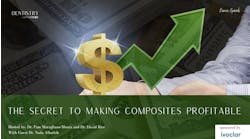Register today to hear Dr. Roger Levin at the PPM Conference in October
It’s difficult to predict the effect of the economy on dental practices. For many years, dental practices were recession proof, which meant they were not affected by the ups and downs of the overall economy. That changed in 2008 when, according to Levin Group data, dental practice production dropped by an average of 10% during what was the longest and deepest recession in US history. It took several years for practices to recover, and then, about 10 years later, the pandemic occurred.
Overall, most practices had record production in 2021. Was there something dentists did to improve practice performance and create these increases in production? Probably not. It had more to do with the stimulus money many Americans were able to access, combined with them not spending money in traditional areas such as travel, entertainment, and restaurants. That scenario has now reverted to people spending their money in the traditional places, and there’s no more stimulus money being offered.
More from Dr. Roger Levin
The economy and your practice: 4 stats to watch
Surviving (even thriving!) in 2021: Findings from the 2021 Dental Economics/Levin Group Annual Practice Survey
Today’s economy
At the time this article was written, US inflation was increasing at about 8% annually. This is significant, and we’re already seeing a strong negative effect on practice overhead. Practices must consider these three factors going forward.Staffing. Staffing has three different factors that impact dental practices. First, there is a shortage of trained staff. In the Dental Economics/Levin Group Annual Practice Survey of 2022, we reported that 64% of practices were seeking to hire at least one team member. We also estimated that 10% of dental hygienists had left the profession, making hiring RDHs difficult. Second, whenever there’s a shortage, practices increase compensation to attract candidates.
Therefore, the shortage has led to a further complication where Levin Group estimates that dental practice staffing costs will rise by as much as 10%. Third, when new staff members are hired at higher compensation, it’s often necessary to increase the compensation of existing staff to retain them and maintain team satisfaction. This raises the compensation level for all dental staff members rapidly and has a financial impact on practice overhead, which is directly proportional to practice profitability.
Inflation. Inflation is currently running at about 8%. Although there are many reasons for the current level, such as supply chain issues, shortages of certain products or services, and businesses that have had to reduce hours or volume due to staffing shortages, inflation will most likely be here for some time. The increases in costs will not simply revert to prepandemic pricing when inflation slows or stops, which means that it will cost more to operate a dental practice for the foreseeable future.
Unlike many businesses that can simply raise their prices, things aren’t as straightforward for dental practices. Many patients are covered by dental insurance plans, and those plans are typically not increasing reimbursements, and some are even working to lower reimbursements. Patients covered by insurance will not contribute to higher fees.
Case acceptance. Typically, when we go through a tough economic time, we expect to see a decrease in case acceptance. In the 2008 recession, we saw many patients skip their hygiene appointments while they waited for the economy to improve. We also saw a decrease in overall treatment acceptance.
It’s difficult to know what impact the economy will have on dental practices in 2023. We already have data indicating that general dental practices are slowing down in production and believe that the level of slowdown will depend on how long the staffing challenge and inflation last.
It’s not all gloom and doom
Here’s the good news. Prior to the pandemic, Levin Group had extensive data demonstrating that almost all dental practices had the potential to increase production by 30%–50% within three years. This statistic has not changed. Even if a practice were to drop by 10% due to economic factors, a 30% gain in three years would still represent 20% growth. A 50% gain in three years would represent 40% growth. Fortunately, dental practices have this level of potential. The reason is the way that practices operate today can be far more efficient and effective if proper systems, strategies, and protocols are in place. Here are a few examples of what you can do.- Reactivate any patient who hasn’t scheduled their next appointment. This may represent your single biggest opportunity to increase practice production. Every day, using excellent scripting, the practice should contact patients who haven’t scheduled their next appointment and get them scheduled. This alone could increase practice production by 10%–12%.
- Improve hygiene productivity. Dental hygienists will be more highly compensated, so it makes sense to maximize the opportunity of their production potential. Immediate opportunities include ensuring that all patients are current on x-rays and fluoride, identifying all gingival or periodontal disease and providing initial services, selling home care products as a routine option, discussing any incomplete treatment or unaccepted treatment plans, and identifying cosmetic services. These strategies can significantly increase overall hygiene production.
- Overhaul or replace the scheduling system. Believe it or not, the same schedule that got you where you are today may restrict further growth. Mathematically rearranging the schedule can often increase practice production if there is a sufficient volume of patients to fill the schedule. Schedules should be constructed using productivity blocks to achieve a daily and annual production goal.
- Increase reviews for the practice. There’s a simple technique we teach that involves properly inquiring about every patient’s level of satisfaction, asking them to provide a review, and giving them a survey card with instructions on exactly how to return it. This has resulted in a large number of practices adding 300 to 400 reviews in less than two years, with almost all of them being five-star reviews.
There are many other ways to increase practice production. Offering the right type of patient financing, explaining interest-free financing, providing phased treatment, encouraging new patients to refer family members for no-cost exams, adding new services, and raising fees annually. There are also secondary factors such as using the correct insurance codes and appealing denied insurance claims.
We are going through a change in the overall economy that is creating some negative effects for dental practices and other businesses. The key to weathering the storm is to take the right strategic steps to ensure that the practice reacts to the economy early enough to avoid negative effects and keep the practice strong. Almost every practice has an opportunity to increase production by 30%–50% if systems are properly updated and implemented, and the team is trained in those systems.
Register today to hear Dr. Roger Levin speak at the 2023 PPM Conference
Editor's note: This article appeared in the January 2023 print edition of Dental Economics magazine. Dentists in North America are eligible for a complimentary print subscription. Sign up here.






